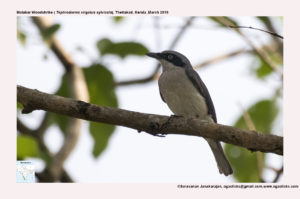Malabar Wood Shrike

Malabar Woodshrike Tephrodornis virgatus sylvicola
Etymology:
- Tephrodornis : Greek word tephrodes – like ashes, ash-coloured; ornis – bird
- Virgatus : Latin word for striped derived from virga –streak
- Sylvicola : Latin word silva – forest; cola – inhabitant.
Vernacular Names: Hindi: Safedgaalakasturi, Sans: Shwet-kanthbhukasturika, H.P.: Malagir, Pun: Santrikasturi, Ben: Dama, Cachar: Daokat-gajauiaba, Guj: Malagirkasturo, Narangikasturo, Mar: Kshitikastur, NarangiDokyachaKastur, Ta: Mampalachittu, Mal: Kozhikili, Koori kannankattupulleh Kan: Shwetakanta thrush, Nicobar: Chook-chyong
Distribution in India: Resident of Peninsular India.
Description: Size of 16·5–18·5 cm. It is a large,dark Woodshrike with broad dark mask, no pale supercilium, white rump and dark tail. The adult has dark grey-brown upperparts and browner remiges, with white underparts, except grey-brown throat and breast. The male has dark blue-grey crown and upper mantle, vaguely paler tips to tertials and secondaries, whitish stripe below mask; all-black bill and yellow iris. The female is very similar, but is dark slaty-brown upperparts, weaker dark grey mask, white fringes to feathers of lower back, vague narrow barring on outer edge of secondaries; bill is dark brown, with paler base to mandible. The immature is much like female, but has distinct pale fringes to remiges and rectrices, and paler base to mandible.
Habitat: It is found in edges and clearings within evergreen forest, moister woodlands in the midstorey and upper strata. It is found from lowlands to 1800 m.
Food habits : It eats insects, also “grubs”. It is associated with mixed-species foraging flocks with minivets and drongosin the non-breeding season. It forages in tree crowns, also in understorey, often moving rather sluggishly; descends to the ground only very occasionally. It gleans from leaves and branches, making short sallies after disturbed insects. It often sallies from a perch; pries into bark fissures on trunks and branches; also takes insects from water surfaces.
Breedinghabits: They breed in Jan–Apr (Kerala); re-nests if first fails. The nest is a shallow saucer of interwoven moss, fibers and pieces of bark, incorporating lichens and bound with cobwebs, placed on horizontal tree branch or at base of main stem above ground. The nest is built over course of 8–12 days. They lay a clutch of 2-3 eggs. The incubation period is 15–16 days. The nestling period is 17 days.